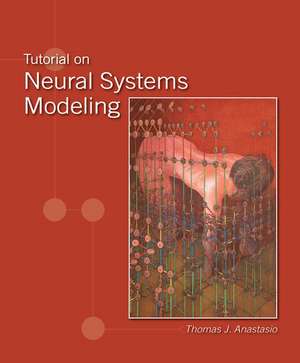Tutorial on Neural Systems Modeling
Autor Thomas J. Anastasioen Hardback – 8 oct 2009
Preț: 938.50 lei
Preț vechi: 1091.28 lei
-14% Nou
Puncte Express: 1408
Preț estimativ în valută:
179.67€ • 187.46$ • 150.61£
179.67€ • 187.46$ • 150.61£
Comandă specială
Livrare economică 10-15 februarie
Doresc să fiu notificat când acest titlu va fi disponibil:
Se trimite...
Preluare comenzi: 021 569.72.76
Specificații
ISBN-13: 9780878933396
ISBN-10: 0878933395
Pagini: 542
Ilustrații: 207
Dimensiuni: 282 x 224 x 31 mm
Greutate: 1.88 kg
Editura: Oxford University Press
Colecția OUP USA
Locul publicării:New York, United States
ISBN-10: 0878933395
Pagini: 542
Ilustrații: 207
Dimensiuni: 282 x 224 x 31 mm
Greutate: 1.88 kg
Editura: Oxford University Press
Colecția OUP USA
Locul publicării:New York, United States
Recenzii
The enthusiasm expressed in the book is infectious. The writing is exceedingly clear and the concepts well expressed.
I am very impressed. Tom Anastasio has created something that has been needed for a long time
I like the level and style of presentation a lot. The MATLAB link is a huge plus, and one that makes all the computations come to life.
The author has done a great job of bringing a variety of models under one umbrella and going over them in detail. I like the fact that there is MATLAB code for hands-on learning. The mathematical details are also clearly explained. Students should have no problem understanding how these models work.
The writing is extremely clear, and the author conveys pretty advanced ideas very well.
I am very impressed. Tom Anastasio has created something that has been needed for a long time
I like the level and style of presentation a lot. The MATLAB link is a huge plus, and one that makes all the computations come to life.
The author has done a great job of bringing a variety of models under one umbrella and going over them in detail. I like the fact that there is MATLAB code for hands-on learning. The mathematical details are also clearly explained. Students should have no problem understanding how these models work.
The writing is extremely clear, and the author conveys pretty advanced ideas very well.
Notă biografică
Thomas J. Anastasio is Associate Professor at the University of Illinois at Urbana-Champaign, affiliated with the Department of Molecular and Integrative Physiology and the Beckman Institute for Advanced Science and Technology. He earned a B.S. in Psychology at McGill University, and a Ph.D. in Physiology and Biophysics from the University of Texas at Galveston. A teacher of courses in computational neuroscience for nearly two decades, Dr. Anastasio has received the James E. Heath Award for Excellence in Teaching Physiology at the University of Illinois. His research focuses on the computational modeling of the nervous system in health and disease.
